
views
- When apologizing to a girl over text, start by acknowledging your mistake and saying that you’re genuinely sorry.
- Take full responsibility, and avoid shifting blame or minimizing your actions. Express genuine remorse for hurting her.
- Back your apology up with actions and improvements to your behavior. Say sorry again in-person the next time you see her.
Put yourself in her shoes.

Before you start writing your text, try to see where she’s coming from. Take some time to empathize with her and think about how you might feel if you were in her position. When you truly understand how she’s feeling, you’ll be better able to figure out what to say in your apology text. For instance, if you forgot her birthday, try imagining how it would make you feel if she forgot about yours. Or, if you made her a promise you didn’t follow through on, think about how you would feel if the roles were reversed.
Say sorry and be specific about what you did wrong.
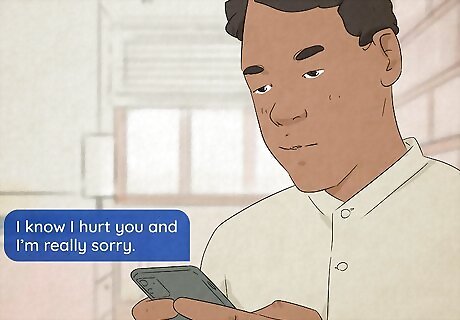
Start by acknowledging what you did and genuinely apologizing for it. No need to beat around the bush—come right out and tell her that you messed up, and that you’re truly sorry. Name the specific thing you did wrong, rather than using vague language. This shows that you’ve reflected on your behavior and understand why it wasn’t okay. For example, text her something like, “I’m so sorry that I was late to our date. You deserve more than that, and I want you to know that I respect your time.” This apology comes across as more genuine than something like “I’m so sorry for screwing up. I’ll do better,” which is too vague and impersonal.
Elaborate on why you were wrong.
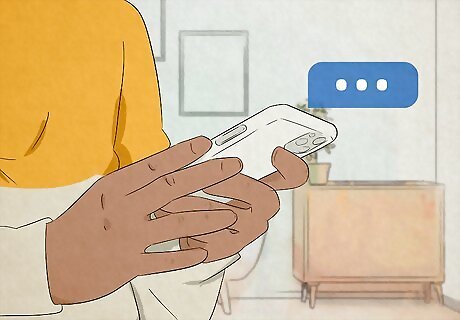
Give details to show you understand the seriousness of your actions. Mistakes are oftentimes more complex than one wrong word or act. Explore all of the reasons your behavior negatively affected her, and demonstrate your understanding of how you hurt her. This will help her see that you’re truly remorseful for your actions. For instance, if you didn’t notice or mention her new haircut, and it hurt her feelings, you could text something like: “I know you were trying something new, and you wanted to see what I thought about it. It takes guts to take a chance like that, and it’s really not okay that I didn’t acknowledge it at all. I’m so sorry, and I think your haircut is beautiful.”
Briefly provide context to your behavior.

Provide any relevant information to explain what went wrong. Context may help her understand why you made the mistake, which could help her forgive you. Be careful, however, not to deflect blame or make things about yourself. Simply explain what happened to give her a full picture of the situation. If you’re apologizing for being late to a date, for instance, you could text something like: “I’m really sorry I didn’t make it to our date on time. There was a car accident on the freeway that held me up. I should have left earlier, or at the very least called to let you know I was running late.”
Take full responsibility for your actions.
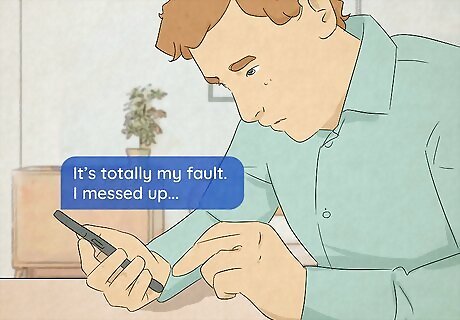
Own up to your mistakes, and avoid making excuses. Acknowledge what you did, and don’t try to shift the blame or justify your behavior. If you’re honest and willing to accept that what you did was wrong, she may be more willing to accept your apology. Your text could say something like, “I’m so sorry I stayed out late last night without letting you know where I was. My behavior was not okay at all, and I take full responsibility for it.” When you’re willing to own your mistakes, she may admit to hers as well. For instance, if she yelled at you for missing her calls, she may apologize for this.
Use active language, not conditional language.
Say you’re sorry that you did something, not if you did something. Conditional language shifts the blame away from you and minimizes your behavior, which can make your apology seem insincere. For example, instead of texting “I’m sorry if I hurt your feelings,” text “I’m sorry that I hurt your feelings.” Here’s a few more examples: What not to say: “I’m sorry if it seemed like I was ignoring you, but I was just busy.” Instead, text something like: “I’m sorry that I wasn’t able to answer your calls. I should have let you know I wasn’t going to be around for a few hours, so you didn’t worry.” What not to say: “I’m sorry if I offended you. It wasn’t my intention to.” Instead, text something like: “I’m sorry for what I said. It was offensive and not okay. I’ll do whatever I can to make it up to you.”
Express genuine remorse for what you did.
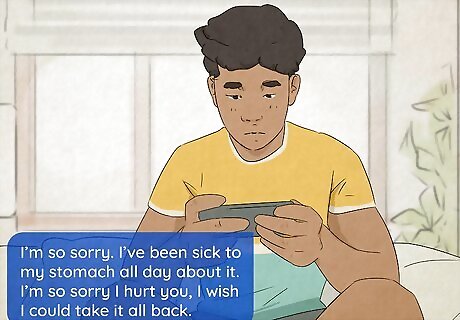
Explain how badly you feel about hurting her. Be vulnerable and open up about the emotions you’re experiencing, whether they be remorse, regret, embarrassment, fear, or some combination of them all. Elaborating on your feelings will make your apology more genuine and effective. For instance, if you said some unkind things in the heat of the moment during an argument, you could text her: “I’m so sorry for what I said. I’ve been sick to my stomach all day thinking about how it must have made you feel, and I'm scared of losing you. I’m so sorry I hurt you, and I wish I could take it all back.”
Give her space to express her feelings.
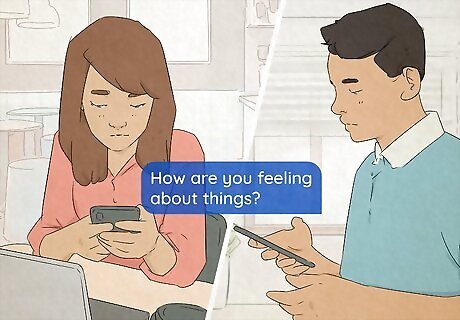
After you send your apology text, give her a chance to respond. Try not to dominate the conversation or keep the focus solely on you. Ask her what she thinks about what you’ve said, and make room for her to share her feelings after you make your apology. Be sure to genuinely listen and make an effort to understand her perspective. For example, after you send your apology text, you could send a follow-up text that says: “How are you feeling about everything? Is there anything you want to talk more about?”
Tell her you want to make up for your mistakes.

Let her know that you are taking action to improve your future behavior. “Actions speak louder than words,” says Courtney Quinlan, a matchmaker and dating coach with over 15 years of experience. “Know her love language, know what’s important to her, know her personality, and use that knowledge to work on getting her back,” she says. For example, if her love language is quality time, you could text something like: “I’m so sorry I had to cancel our date at the last minute. If you’re free this weekend, I would love the chance to spend some time with you. You don’t have to do anything at all—I’ll make the reservations and plan everything out!” This will show her you’re ready and willing to do whatever it takes to fix any damage your mistakes have made.
Remember that you’re asking her to forgive you.
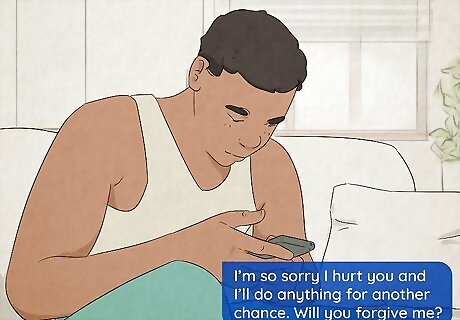
Request her forgiveness—don’t just expect it. After you’ve apologized, admitted your mistakes, and tried to make amends, ask her if she’s willing to accept your apology and forgive you. She may need some time to think it over, and that’s okay. “If she needs her space, give her all the space she needs,” says Courtney Quinlan. Let her accept the apology in her own time, and on her own terms.
Follow up in person.

Repeat your apology the next time you see her. An apology text is a great start, especially if you’re worried about being able to express yourself verbally. It’s important to back this text up, however, with a sincere face-to-face apology at some point. Many people prefer an in-person apology, especially when you’re apologizing for a breach of trust, so this may be the final step to truly move forward. When you see her in person, tell her you’re sorry again, and make sure you live up to any promises or commitments you made when you sent your apology text. For instance, if you apologized for being late to a date and promised that it wouldn’t happen again, take extra care to be punctual when you see her next.



















Comments
0 comment